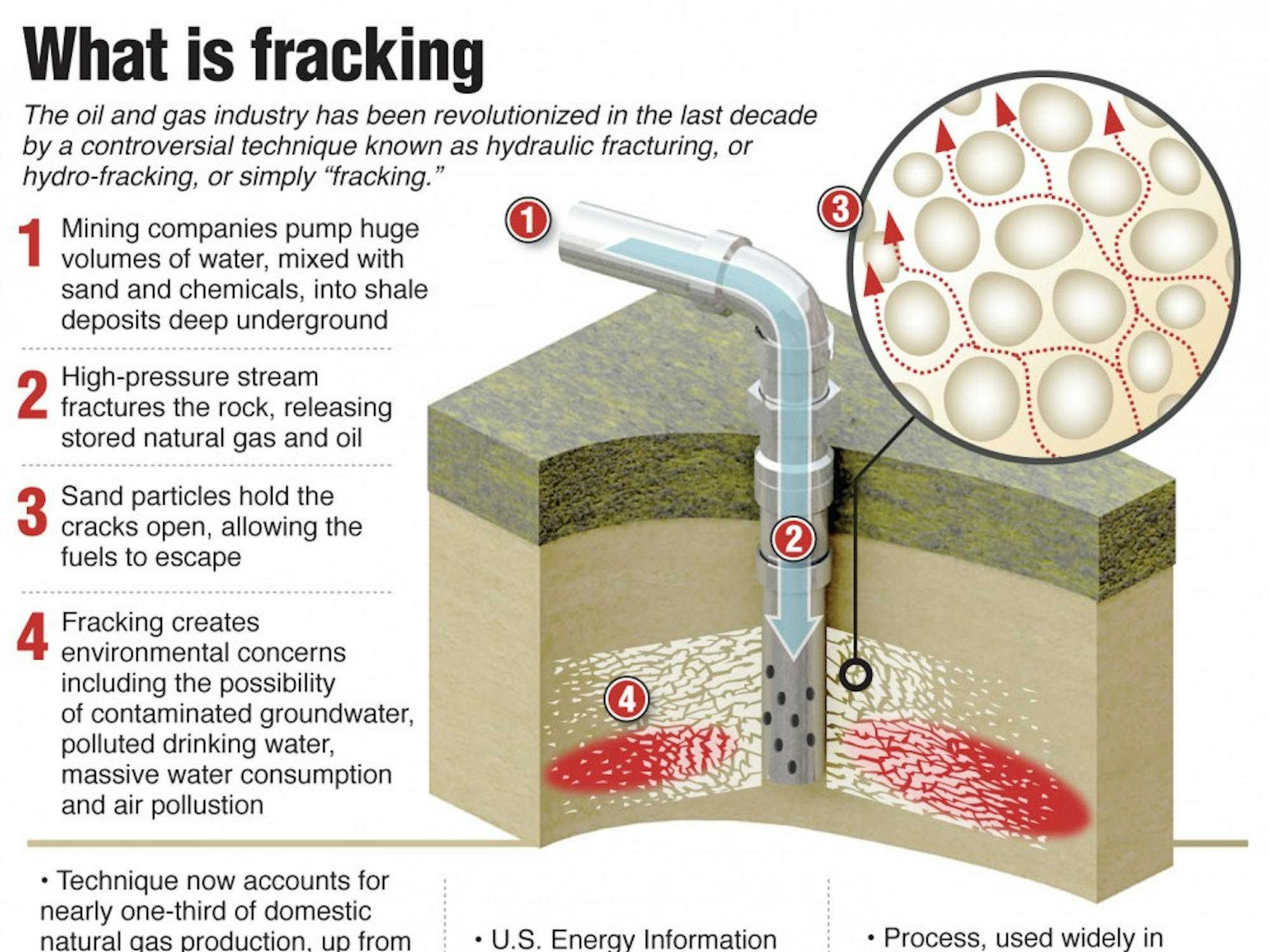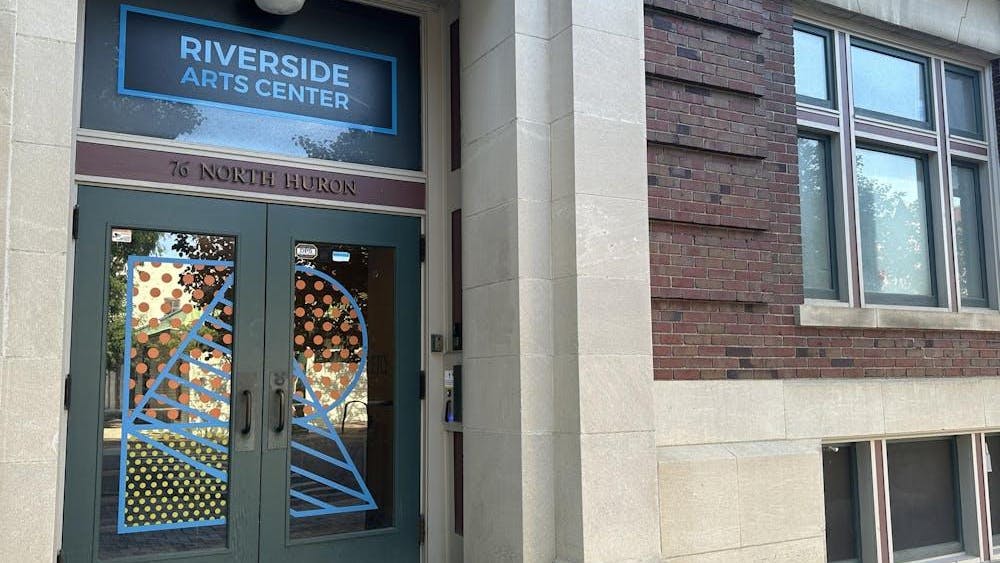The ad-hoc student government committee on energy and sustainability held a meeting Thursday to discuss hydraulic fracturing, better known as fracking.
As the number of people using cars grows and the planet’s supply of oil dwindles, petroleum companies across the world are desperately seeking to find a newer, more efficient, more reliable way of supplying gasoline.
Rather than actual alternative fuel sources, oil companies are looking towards a new method of getting and using oil fracking.
Student Senator Kody Vitale helped organize the event. He said he wanted to show the dangers of hydraulic fracturing and inform people about some of the alternatives to the eco-damaging practice of fracking.
“[The objective] is just to raise awareness around campus of hydrofracking and just to provide students with knowledge about how to prevent hydrofracturing,” said Vitale.
It should be pointed out however, that fracking has been around since the 1940s. What has become the issue is a newer, more heavy-duty method that has come into being fairly recently, and has already become a multi-billion dollar industry in places like Alberta. But it is possible that such operations could come to happen in Michigan.
According to MSN, companies like C & J Energy Service, Nuverra Environmental Solutions, and US Silica Holdings made a $79 million profit in 2012. These companies, along with Suburban Propane, the country’s biggest propane distributor, are all involved in fracking. All of their websites have information on fracking, and insist that it can be safe if the process is followed properly.
Tie Hornesby, the president of the student-based environmental group GREEN, in opposition to the claim of fracking safety, said: “Two big things behind that…Methane as a gas is more hazardous than CO2 carbon emissions. The other factor behind that is that the other chemicals that are used for fracking are not open to the public. And what chemicals are open are carcinogens.”
With the new fracking technique, the companies take millions of gallons of fresh water and mix it with a cocktail of chemicals, which are then poured into a well to break down the shale. This mixture breaks down the bedrock, and the companies then extract the oil or natural gas. Resources like oil and natural gas, which were previously too hard to access, no longer are.
Thanks to recent technological developments, natural gas has become cheaper and more easily accessible than the longtime staple, coal.
As a result of fracking, natural gas is being seen as the new catalyst for powering our world, at least for a short time.
Eastern uses natural gas as well. The power plant behind the library buys natural gas direct from the provider.
“The amount of water a fracking operation uses is equivalent to what Traverse City uses in two years,” Erick Keller of Clean Water Action said. He was the headlining speaker at the hour-long event.
Clean Water Action is a one million-member grassroots organization dedicated to protecting water supplies. It began as the Fisherman’s Clean Water Alliance in 1972. The 21-state group has had many successes, including helping passing the Clean Water Act in the 70s.
Clean Water brought up a number of concerns about the fracking process. Clean Water also commented on the difficulty of proving that the fracking operation caused pollution spills.
According to Clean Water, fracking companies do not have to tell the public how, or what, chemicals are being used, and insist that the lack of transparency is vital to their businesses.
Keller explained that the new fracking technique can dig two miles deep and two miles diagonally.
“What they’re doing nowadays is that they’ll have their well pad, they’ll have their equipment and they’’l either drill down or they’ll drill sideways to get it so they can get to stuff that they couldn’t get to. The new fracking … uses a lot more stuff,” Keller said. “[It’s] not your grandfather’s fracking.”
“They are looking to start some hydrofracking in Fowlerville,” Vitale said. “And although there might not be as much fracking going on in Michigan there’s plenty of natural gas consumption that is supporting [fracking] somewhere else.”
According to the Detroit Free Press, about 15 wells using the new fracking method have been dug, and there are 52 applications waiting for approval.
“The state has never denied a fracking permit,” Keller said.
Clean Water Action says the wells use up to 20 or 30 million gallons of groundwater in a typical fracking operation.
Additionally, 95.1 percent of what’s used is water and sand. Less than half of one percent of the material used are chemicals of concern.But when those numbers are taken to scale, there are still millions of gallons of chemicals in a well.
“The majority of it comes back up,” Keller said. “The wastewaters, which the industry calls flowback, comes back to the surface, then in a variety of ways they dispose of it. They either have to a dried up well that’s not used anymore, that’s been capped, then drop it. Or there’s open ponds where they just let it evaporate and then they dispose of it in landfills.”
Most of the fracking alternatives discussed at the meeting focused on wind power, which Keller said were cheaper then natural gas and coal.
Wind contracts are locked for 20-year rates, rather than traditional rates which change year to year. Clean Water Action has helped proposed a series of bills in the state house, but the laws are yet to be passed.
If you’re interested in supporting Clean Water Action in stopping fracking in Michigan, visit Clean Water Action’s website.








